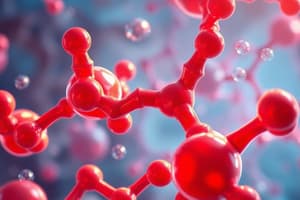Podcast
Questions and Answers
What is cholesterol specifically classified as?
What is cholesterol specifically classified as?
a steroid
Which hormones are made from cholesterol?
Which hormones are made from cholesterol?
estradiol and testosterone
Which of the following characteristics is not true for saturated fats?
Which of the following characteristics is not true for saturated fats?
- They have no double bonds between carbon atoms.
- They are usually derived from animal sources.
- They tend to dissolve in water easily. (correct)
- They are solids at room temperature.
Which fat has the least number of hydrogen atoms?
Which fat has the least number of hydrogen atoms?
Of what are phospholipids important components?
Of what are phospholipids important components?
What is the basic structure of a steroid?
What is the basic structure of a steroid?
Besides its use in hormone production, for what does the body use cholesterol?
Besides its use in hormone production, for what does the body use cholesterol?
What are the four classes of lipids and what is an example of each?
What are the four classes of lipids and what is an example of each?
Why have trans fats been banned from some restaurants?
Why have trans fats been banned from some restaurants?
What is it about the structure of fatty acids that gives them their physical characteristics?
What is it about the structure of fatty acids that gives them their physical characteristics?
In phospholipids, glycerol backbone is attached to two fatty acid molecules and one phosphate group.
In phospholipids, glycerol backbone is attached to two fatty acid molecules and one phosphate group.
Fats have predominantly saturated fatty acids and oils have predominantly unsaturated fatty acids.
Fats have predominantly saturated fatty acids and oils have predominantly unsaturated fatty acids.
Omega 3 is an essential fatty acid because it is not synthesized by the body.
Omega 3 is an essential fatty acid because it is not synthesized by the body.
Unsaturated fatty acids can exist in cis and trans configuration.
Unsaturated fatty acids can exist in cis and trans configuration.
Cis fatty acids have kinks and are major constituents of liquid oils.
Cis fatty acids have kinks and are major constituents of liquid oils.
Saturated fats can be hydrogenated to form saturated fatty acids.
Saturated fats can be hydrogenated to form saturated fatty acids.
LDL is bad cholesterol and HDL is good cholesterol.
LDL is bad cholesterol and HDL is good cholesterol.
Waxes are a class of lipids that constitute long chain alcohols esterified to long chain fatty acids.
Waxes are a class of lipids that constitute long chain alcohols esterified to long chain fatty acids.
Facilitated diffusion is still a passive transport.
Facilitated diffusion is still a passive transport.
Phospholipids in animals can be of only four types.
Phospholipids in animals can be of only four types.
Triglycerides have fatty acids esterified with glycerol backbone, and phospholipids are triglycerides where one fatty acid chain is replaced by a phosphate group.
Triglycerides have fatty acids esterified with glycerol backbone, and phospholipids are triglycerides where one fatty acid chain is replaced by a phosphate group.
Choline, ethanol amine, serine, and inositol are four organic molecules that are attached to phosphate group in the phospholipids and only serine is negatively charged, others are neutral.
Choline, ethanol amine, serine, and inositol are four organic molecules that are attached to phosphate group in the phospholipids and only serine is negatively charged, others are neutral.
Flashcards are hidden until you start studying
Study Notes
Cholesterol and Hormones
- Cholesterol is classified as a steroid.
- Estradiol and testosterone are hormones derived from cholesterol.
Characteristics of Fats
- Saturated fats are incorrectly believed to dissolve easily in water.
- Unsaturated fat has the least number of hydrogen atoms compared to other fats.
Phospholipids
- Phospholipids are crucial components of the plasma membrane in animal cells.
- Their structure consists of a glycerol backbone linked to two fatty acids and one phosphate group.
Lipid Classes
- Lipids can be categorized into four classes:
- Fats (e.g., margarine)
- Waxes (e.g., coating on feathers)
- Phospholipids (e.g., cell membrane constituents)
- Steroids (e.g., cholesterol)
Trans Fats
- Trans fats are created by hydrogenating oils, increasing saturation and isomerization, leading to higher LDL levels.
- Some restaurants have banned trans fats due to health concerns.
Fatty Acid Structures
- The difference in physical characteristics among triglycerides is due to the structure of their fatty acids.
- Unsaturated and trans fats contain double bonds in their carbon chains, while saturated fats do not.
Fats and Oils
- Fats predominantly contain saturated fatty acids whereas oils contain predominantly unsaturated fatty acids.
Essential Fatty Acids
- Omega-3 fatty acids are essential as the body cannot synthesize them.
Configurations of Fatty Acids
- Unsaturated fatty acids can exist in both cis and trans configurations, with cis forming kinks that contribute to their state as liquid oils.
Hydrogenation
- Saturated fats can undergo hydrogenation to become saturated fatty acids.
Cholesterol Types
- LDL is classified as "bad" cholesterol and HDL as "good" cholesterol.
Waxes
- Waxes consist of long-chain alcohols esterified to long-chain fatty acids, differing from triglycerides where fatty acids are linked to glycerol.
Transport Mechanisms
- Facilitated diffusion is a type of passive transport.
Types of Phospholipids
- Major phospholipid types in animals include:
- Phosphatidylcholine (PtdCho)
- Phosphatidylethanolamine (PtdEth)
- Phosphatidylserine (PtdSer)
- Phosphatidylinositol (PtdIns)
Triglycerides and Phospholipids
- Triglycerides consist of fatty acids esterified with a glycerol backbone, while phospholipids have one fatty acid replaced with a phosphate group.
Organic Molecules in Phospholipids
- Four organic molecules attached to the phosphate group in phospholipids include choline, ethanolamine, serine, and inositol. Only serine possesses a negative charge, with the others being neutral.
Studying That Suits You
Use AI to generate personalized quizzes and flashcards to suit your learning preferences.




